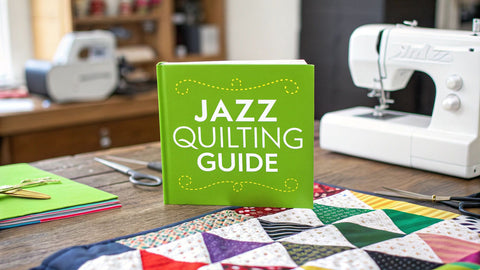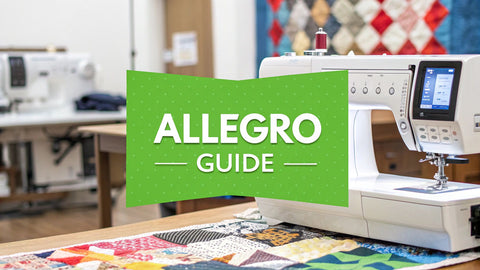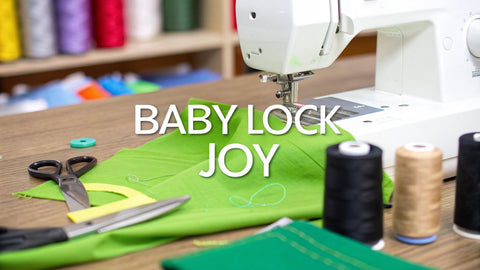If you've ever tried to wrestle a big, beautiful quilt through a standard sewing machine, you know the struggle. The constant bunching, pulling, and cramming can turn a project of passion into a total headache. That frustration is exactly what makes the Baby Lock Jazz Sewing Machine feel like a breath of fresh air for quilters and crafters.
What’s its secret? A massive 12-inch throat space. This isn't just a minor upgrade; it's a complete game-changer for anyone working on ambitious projects.
Why Crafters Love the Baby Lock Jazz
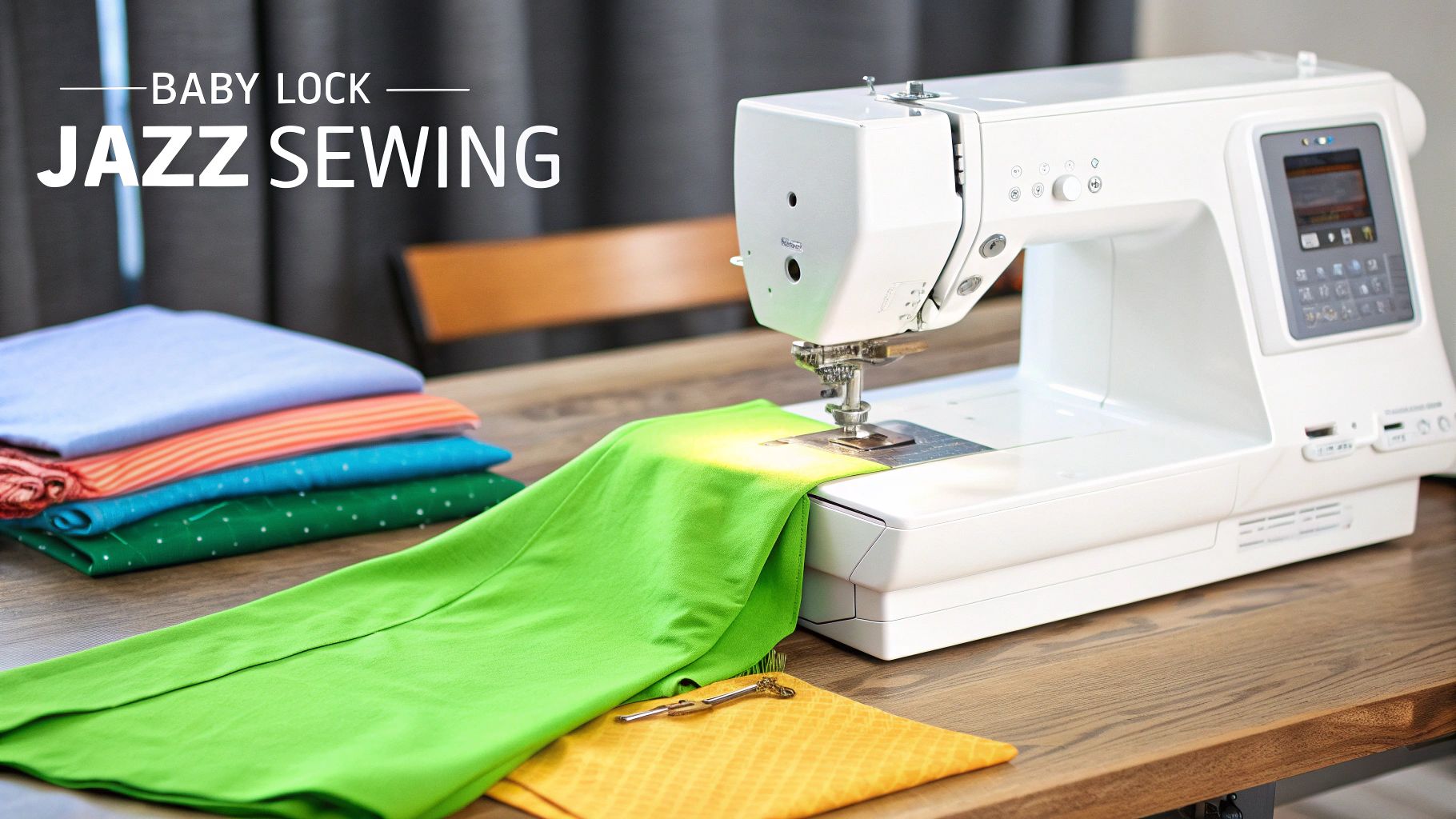
For a crafter, workspace is everything. Trying to guide a king-sized quilt through a machine with only a 6-inch throat is like trying to paint a mural in a tiny closet. It’s cramped, you can't see what you're doing, and the final result often shows the strain.
The Baby Lock Jazz completely demolishes that barrier. With a full 12 inches of workspace, you finally have the room to move. You can glide your fabric freely for intricate free-motion patterns, stipple designs with ease, or topstitch a large handbag with perfect visibility and control.
Think of this as your personal "how-to" guide for the Jazz, from the moment you get it out of the box to the thrill of creating your first custom design. We’ll walk through tangible examples you can replicate, showing how its solid build and straightforward features make even the most complex projects feel manageable.
Built for Creativity and Empowerment
Here at bsewinn.com, we believe that buying a great machine is just the first step. To truly empower your creativity, you need the support to make it sing. That’s why we’ve built a comprehensive ecosystem to help you get the most out of your Baby Lock Jazz and unlock its full potential. We're committed to your crafting journey.
Our empowerment resources include:
- Custom Sewing Machine Designs: Get access to unique patterns and project ideas that you can replicate, made specifically to showcase the capabilities of the Baby Lock Jazz.
- Online Classes and Training: Whether you're mastering the basics or learning advanced free-motion techniques, our expert-led classes provide step-by-step guidance.
- Extensive Resources: Explore our library of tutorials, how-to guides, and community forums for inspiration and answers to any questions you might have.
The Baby Lock Jazz isn't just a tool; it's a creative partner. It was designed with a crafter’s needs in mind, giving you the space and power to bring your grandest ideas to life without having to compromise.
We’re going to break down every part of this incredible machine so you feel confident from the very first stitch. If you’re ready to take a closer look, you can find all the details and specs on our Baby Lock Jazz II Sewing Machine page.
Let’s get creating.
Diving Into the Core Features
To really get what makes the Baby Lock Jazz such a special machine, you have to look past a simple spec sheet. Every feature was put there for a reason, designed to solve a real-world problem for sewists, especially those of us who love big projects like quilts. It’s the smart thinking behind the design that elevates the whole experience.
Take the machine's impressive speed, for example—it clocks in at 1,000 stitches per minute. That's not just about getting done faster; it's about keeping your rhythm. When you’re chain-piecing blocks for a quilt or sewing long seams for custom drapery, that steady, powerful speed gives you beautifully even and strong stitches. It helps you fly through the foundational parts so you can get back to the fun, creative stuff.
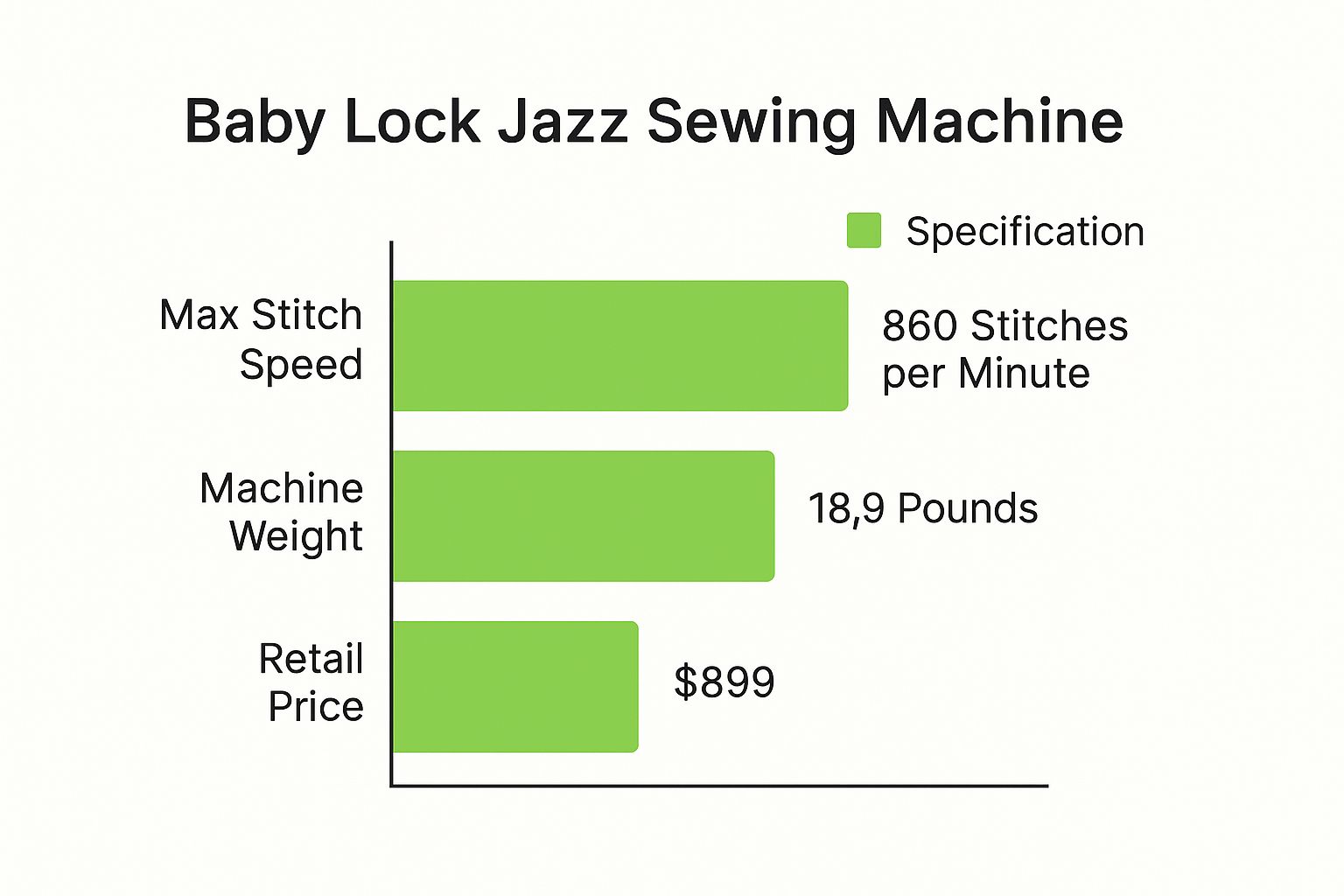
The machine is clearly built for serious crafting, packing high-speed performance into a solid, stable frame—all at a really competitive price.
A Crafter's Dream: Workspace and Pinpoint Control
One of the absolute best things about the Jazz is its massive 12-inch throat. Think of it as having a huge, clear workbench right on your machine. It gives you all the room you need to move a king-sized quilt or a bulky winter coat without everything getting bunched up. This means your free-motion quilting glides smoothly and your topstitching stays perfectly straight.
That extra space also cuts down on fabric drag, which is a notorious culprit behind skipped stitches and wonky tension.
Another feature that completely changes the game is the programmable needle up/down function. Picture this: you're quilting a tricky pattern with lots of sharp turns. Instead of fumbling with the handwheel every time you need to pivot, you just program the needle to stop in the down position. Simple.
This one little button has a huge impact on your work:
- Perfect Pivots: It anchors your fabric right where you need it, letting you lift the presser foot and turn your project with total precision.
- Better Control: You get to keep both hands on your fabric to guide it, instead of needing one to crank the handwheel.
- Fewer Mistakes: It takes away the risk of accidentally shifting your project and knocking your stitches out of alignment when you turn a corner.
If you're just starting out, getting the hang of these features will make a world of difference. Our guide on the 4 easy steps to start quilting is a great place to begin, and it pairs perfectly with the Jazz's user-friendly design.
Designed for Uninterrupted Sewing
Is there anything more frustrating than getting into a creative groove, only to be stopped dead by an empty bobbin? The Baby Lock Jazz tackles this problem head-on with a large-capacity M-class bobbin. It holds way more thread than a standard bobbin, which means you can stay "in the zone" for much, much longer.
This kind of thoughtful design is what Baby Lock is all about. They’ve been innovating since 1968 and have built a reputation for quality, with over 600 retailers in North America alone. Their machines are known for being durable, user-friendly, and packed with features that actually help you sew better.
Here’s a quick look at how the Jazz’s key features stack up for quilters and anyone tackling big projects.
Baby Lock Jazz Feature Breakdown
The table below breaks down the specs that matter most, showing why the Jazz is such a powerhouse for quilting and large-scale sewing.
| Feature | Specification | Benefit for Crafters |
|---|---|---|
| Throat Space | 12 inches | Easily handles large quilts and bulky projects without bunching. |
| Maximum Stitch Speed | 1,000 SPM | Finishes long seams faster and provides smooth, consistent power. |
| Bobbin Type | Large M-Class | Holds more thread for fewer interruptions during sewing. |
| Needle Position | Programmable Up/Down | Ensures perfect pivots and precise corners with hands-free control. |
When you put them all together, these core features create a machine that’s both incredibly powerful and a joy to use. It’s built to handle ambitious projects, giving you the freedom to bring your biggest and best ideas to life with fewer roadblocks.
Getting Your Machine Set Up for the First Time
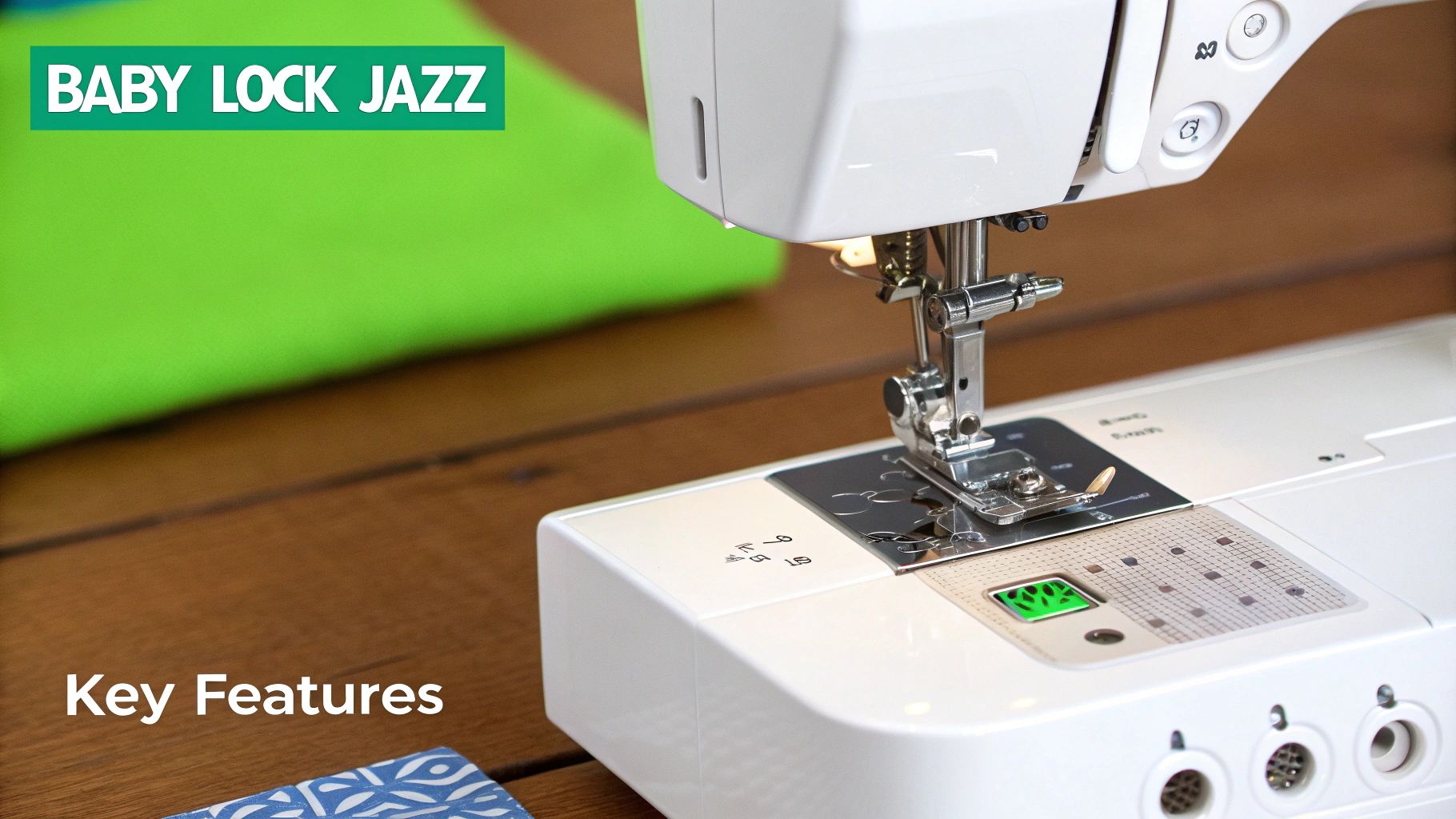
There’s nothing quite like the feeling of unboxing a brand new sewing machine. That first moment with your Baby Lock Jazz is brimming with possibility. Getting it ready to sew shouldn't feel like a chore; it’s the first step on your next creative adventure. I’ll walk you through it so you can get to the fun part—the actual sewing—as quickly as possible.
Think of this like setting up a new workspace. You need a solid foundation before you can really get down to business. First things first, attach that big extension table. It’s not just an optional accessory; it’s what gives the Jazz that massive, supportive surface quilters and garment makers dream of. Just slide it into place until you hear a satisfying click. Your workspace just doubled, and you’re ready for success.
With the machine physically set up, let's talk thread. Winding a good, tight bobbin is one of those little things that makes a world of difference. It’s the secret to avoiding those frustrating thread nests and tension headaches later on.
Winding a Flawless Bobbin
Seriously, a poorly wound bobbin can ruin your day, leading to tangled thread and skipped stitches. Taking a minute to get it right from the start is time well spent. The Jazz makes this super easy with its top-loading system and built-in winder.
- Pop on Your Thread: Place your spool of thread onto the spool pin and slide the right-sized spool cap on to hold it snugly.
- Follow the Path: Look for the numbered diagrams on the machine and guide your thread along that path. This ensures it winds onto the bobbin with the perfect amount of tension.
- Prep the Bobbin: Poke the thread end through the little hole on your M-class bobbin, then place the bobbin on the winder spindle.
- Wind It Up: Push the winder to the right to lock it in. Hold onto the thread tail for a second as you press the foot pedal. The machine takes over from there and stops automatically when it’s full.
Once your bobbin is wound, just drop it into the case right by the needle plate. I love that it has a clear cover—you can see exactly how much thread you have left with a quick glance. No more surprise thread run-outs in the middle of a long seam!
Threading the Needle with Ease
For many, threading the needle is the most dreaded part of sewing. But the Jazz takes all the frustration out of it with its built-in needle threader.
Just follow the numbered guides printed right on the machine. You’ll bring the thread down, around, and back up, then use the handy threader mechanism to pop it right through the needle’s eye. It’s a game-changer.
Now you just need to pick the right tools for your first project. A universal size 14 or 16 needle is a great all-rounder for medium-weight fabrics like quilting cotton. Pair that with a good quality, all-purpose polyester thread, and you'll have strong, beautiful seams from the get-go.
This whole setup process is more than just a checklist. It's about you and your new machine getting to know each other. When you understand these simple steps, you build the confidence to jump into any project that catches your eye.
Here at bsewinn.com, we believe that confidence comes from knowing your tools inside and out. Our online classes and training videos are made to go hand-in-hand with your machine's manual, offering clear, visual steps that make learning feel natural. We want you to go from unboxing to creating without any of that initial intimidation.
Okay, your Baby Lock Jazz is all set. Let's make that first stitch.
How-To: Create Your First Designs with the Baby Lock Jazz
Alright, you’ve got your Baby Lock Jazz sewing machine threaded and sitting pretty. Now, the real fun begins. This is where we move past the setup and start turning that beautiful fabric into something amazing. Think of this as your hands-on workshop, the part where you replicate tangible designs and your machine becomes a true creative partner.
First up is a fundamental skill for any crafter: the perfectly straight seam. Nailing those crisp stitch lines is what gives quilt blocks, tote bags, and garments that professional, polished look. The Jazz’s powerful motor and rock-solid frame give you incredible control, letting you guide fabric smoothly for seams that look absolutely flawless.
Example Project: A Simple Four-Patch Quilt Block Start with this classic design. Cut four identical 5-inch squares of fabric. Place two with their right sides together and stitch along one edge using a standard quarter-inch seam allowance. You’ll immediately notice how consistent and straight your stitches are. Press the seam open, repeat with the other two squares, and then sew the two pairs together to complete your first block.
Diving Into Free-Motion Quilting
Once you've mastered straight lines, it's time to let your artistic side run wild with free-motion quilting. This is where that massive 12-inch throat space on the Baby Lock Jazz really gets to shine. It gives you all the room you need to "draw" with your needle, creating swooping curves, stipples, and intricate patterns without ever feeling like your quilt is bunched up against the machine.
To get set up for free-motion quilting, it only takes a few steps:
- Attach the Darning Foot: This special foot (often included with the machine) hovers just over the fabric instead of clamping it down. This is what lets you move your project in any direction you want.
- Lower the Feed Dogs: Find the switch on your machine that disengages the little teeth that normally pull the fabric forward. This one simple action puts you in complete control of where the fabric goes and how fast.
- Create a Practice Sandwich: Before you start on your actual quilt, layer a top fabric, a piece of batting, and a backing fabric. This little quilt sandwich is the perfect canvas for practicing your stitching without any pressure.
Example Project: Free-Motion Meander Start by moving the fabric in gentle, consistent motions. Try drawing a continuous, loopy "meander" pattern across your practice sandwich. The goal is to get a feel for matching the speed of your hands with the speed of the needle—that’s the secret to creating even, beautiful stitches that you can later apply to a full quilt.
Understanding Your Presser Feet
Your Baby Lock Jazz came with a whole set of presser feet, and each one is a specialized tool designed for a specific job. I like to think of them like different bits for a power drill; using the right one makes the task a million times easier and the results so much cleaner.
Learning what each foot does is a key step in moving from a beginner to a confident sewist. It unlocks techniques and precision you might have thought were out of reach.
For example, the Walking Foot is a quilter's absolute best friend for stitching through multiple layers. It has its own set of feed dogs that work with the machine's, which prevents the layers of your quilt from shifting and puckering. The Zipper Foot is super narrow, letting you stitch right up against zipper teeth for a clean, professional finish on bags or clothes.
Adjusting for Perfect Stitches
Let's be honest, not all fabrics are created equal. A lightweight cotton behaves very differently from a heavy denim or a slippery satin. Learning how to adjust the tension and stitch length on your Baby Lock Jazz sewing machine is what turns frustrating trial-and-error into predictable, beautiful results, every single time.
A good habit to get into is always testing your stitches on a scrap piece of your project fabric before you start. If your stitches are loopy on the bottom, your top tension is probably too low. If you see the bobbin thread getting pulled up to the top, your tension is too tight. The sweet spot is a perfectly balanced stitch where the threads meet neatly right in between the fabric layers.
The Baby Lock brand has a fantastic reputation for delivering high-quality machines that don't come with an outrageous price tag. In the busy sewing machine market, Baby Lock machines have an average price of around USD 864, positioning them as a great option for serious hobbyists. This pricing is right in line with other respected brands like Janome and Juki, showing a real commitment to both quality and value. For more great insights on how different brands stack up, you can check out comparisons on Quiltingroomwithmel.com.
Here at bsewinn.com, we're all about empowering you with the knowledge to use your machine to its absolute fullest. Our online classes and training resources are designed to walk you through these essential techniques, providing real-world examples and fun projects that build your skills one stitch at a time.
Keeping Your Machine in Peak Condition

Your Baby Lock Jazz Sewing Machine is a serious workhorse, designed to be your creative partner for years. But just like any good relationship, it needs a little TLC to stay at its best. Setting up a simple maintenance routine is the single best thing you can do to protect your investment and make sure it's running just as beautifully years down the road as it did right out of the box.
Think of routine cleaning as preventative medicine for your machine. As you sew, tiny bits of lint and dust from your fabric and thread work their way into every nook and cranny, especially around the bobbin case and under the needle plate. This fluff acts like a sponge, soaking up lubricant, gumming up the moving parts, and eventually leading to headaches like skipped stitches or a noisy machine.
Taking just a few minutes to clean up after every few projects can stop these problems before they even start. It's a small habit that pays off big time in stitch quality and peace of mind.
Your Simple Maintenance Schedule
The key here is consistency. You don't need to do a complete teardown every time you sit down to sew, but a regular rhythm of care will make all the difference. Having a plan takes the guesswork out of it and turns machine care into a quick, easy habit.
Here’s a simple schedule that works wonders:
- After Every Project: Give the machine a quick wipe-down with a soft, dry cloth to get rid of surface dust. Then, grab the little brush that came with your Jazz and sweep out any visible lint from the bobbin area and around the needle plate.
- Every 8-10 Hours of Sewing: Time for a new needle! A dull needle is the number one cause of pulled threads, skipped stitches, and wonky tension. This is such a tiny change, but it has a massive impact on how good your stitches look.
- Monthly (or after a big quilt): Now it's time for a deeper clean. Take off the needle plate and pop out the bobbin case. This gives you access to the feed dogs and the hook race area where lint really loves to hide. Use your brush and maybe a pair of tweezers to gently clear out all that compacted fluff.
Regular maintenance isn’t about fixing problems—it’s about preventing them. A clean machine is a happy, reliable machine, which means you can focus on your creativity without getting sidetracked by frustrating hiccups.
Common Issues You Can Easily Fix
Even with the best care, you’ll probably run into a minor snag now and then. The great thing is, most common sewing machine frustrations are things you can easily troubleshoot and fix yourself in just a few minutes. Knowing how to handle these little things is super empowering, and it’s a big part of what we teach through our online training and resources at bsewinn.com.
Here are a few common culprits and their quick fixes:
- Skipped Stitches: Nine times out of ten, this is a needle issue. It's either dull, bent, or simply the wrong type for your fabric. Your first move should always be to pop in a fresh, new needle of the correct size.
- Thread Nests (Bird's Nests): That dreaded tangled mess of thread on the bottom of your fabric almost always points to a problem with the upper threading. Take the top thread out completely and re-thread the whole machine from the beginning. Crucially, make sure the presser foot is up so the tension discs can open up and grab the thread properly.
- Uneven Tension: If your stitches look loopy on the top or bottom, the first step is to re-thread everything—both the top thread and the bobbin. Double-check that the bobbin is seated correctly in its case and that the top thread is sitting snugly in the tension assembly.
Getting comfortable with these simple maintenance and troubleshooting tasks will make you a more confident sewer. You'll spend less time fighting with your machine and more time doing what you love: bringing your amazing ideas to life.
Your Partner in Boundless Creativity
The Baby Lock Jazz Sewing Machine is so much more than just a tool; it's an invitation to really think bigger. We've walked through how its massive workspace, powerhouse motor, and thoughtful design tear down the physical walls that can sometimes fence in our creativity. Whether you're dreaming up sprawling quilts, custom home decor, or that ambitious garment you've been putting off, this machine is truly built to handle those large-scale projects with grace.
You've got the skills down, but what comes next on your creative journey is entirely up to you. We hope you feel empowered to explore the limitless possibilities that are now right at your fingertips.
Your Creative Journey with bsewinn.com
Think of us as a dedicated partner in your craft. Here at bsewinn.com, we offer a whole world of support to help inspire your next big idea. Our goal is simple: to empower crafters by providing the resources needed to bring any vision to life.
Our commitment to your empowerment includes:
- Custom Sewing Designs: Unique, replicable projects made specifically to show off what your machine can do.
- Expert-Led Online Classes: Pick up new skills and master advanced techniques, all from the comfort of your sewing room.
- A Supportive Community: Connect with other makers to swap ideas, ask for advice, and show off your amazing work.
It's a really exciting time to be a sewer. The sewing machine industry is a dynamic space, valued globally at a staggering USD 6.25 billion in 2024 and it's only expected to grow. North America is a huge part of that, thanks to crafters who are embracing powerful, feature-rich machines like the Jazz. If you're a numbers person, you can dive deeper into these market trends in this detailed report from maximizemarketresearch.com.
The Baby Lock Jazz gives you the power to move beyond the ordinary. It’s a machine built not just for sewing, but for realizing the full scope of your creative vision, no matter how ambitious it gets.
If the Jazz's incredible capabilities have you inspired, you might also want to check out our guide on the Baby Lock Allegro Sewing and Quilting Machine. It's another fantastic option for tackling those beautifully expansive projects.
Your Questions, Answered
Jumping into the world of a powerful new sewing machine like the Baby Lock Jazz always brings up a few questions. It's a big decision! To help you feel completely confident, I've put together answers to the most common things people ask about this creative workhorse.
My goal here is to give you the real-deal, straightforward info you need. It’s the same approach we take at bsewinn.com, where we empower every crafter with online classes, training, and extensive resources.
Is the Baby Lock Jazz Good for Beginners?
Yes, absolutely—especially for an ambitious beginner who's excited to grow. While it has the kind of power and space that seasoned experts dream of, the Jazz is surprisingly welcoming and not the least bit intimidating.
Little things that trip up new sewists, like threading the needle or figuring out the controls, are made simple with features like the built-in needle threader and a super clear threading path. But the real game-changer is its huge 12-inch throat space. It lets you dive right into big, exciting projects like quilts or curtains without immediately feeling boxed in by your machine. That’s how you build confidence and keep the fun going.
Can I Use It for Regular Sewing, or Is It Just for Quilting?
I get this question all the time! While that massive workspace makes quilters' hearts sing, the Baby Lock Jazz is a true all-around powerhouse perfect for any kind of sewing. It's not a one-trick pony.
Its strong motor and speedy stitching can power through heavy-duty fabrics like denim or canvas for garment making just as beautifully as it handles precise quilt piecing. That giant throat space is a lifesaver for more than just quilts, too. Think about sewing things like:
- Bulky winter coats and jackets
- Flowing custom drapery
- Big tote bags or upholstery projects
The Jazz is built to keep up with you, no matter which creative path you wander down. It’s the kind of machine that grows right alongside your skills.
The Baby Lock Jazz was engineered from the ground up to be both a beast and a beauty. It delivers the muscle for the most demanding sewing jobs while keeping the finesse needed for delicate quilting, making it an incredible asset in any sewing room.
What Kind of Maintenance Does It Require?
You'll be happy to hear that keeping your Jazz running smoothly is incredibly simple. It really comes down to a few good habits: cleaning out the lint, changing your needle regularly, and keeping it covered when you're not using it. Honestly, doing just that will prevent most of the common hiccups people run into.
For peak performance, just follow this easy routine:
- Clean After Each Project: Grab a little brush and sweep the lint out of the bobbin area and from around the feed dogs. It only takes a minute!
- Change the Needle Often: A fresh needle every 8-10 hours of sewing is the golden rule. It’s the secret to preventing skipped stitches and protecting your fabric.
- Follow the Manual: Your owner's manual will show you where to put a drop of oil now and then. This keeps all the internal parts moving like a dream for years to come.
Ready to stop wrestling with a machine that holds you back and start creating with total freedom? At B-Sew Inn, we’re here to empower you with the tools and support to bring your biggest ideas to life. It’s time to explore the machine that gives you the space to dream bigger.

